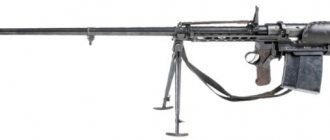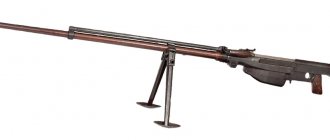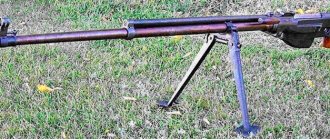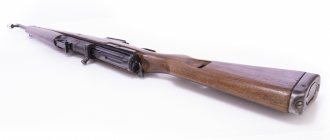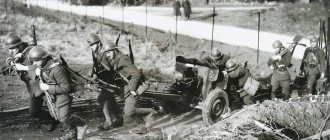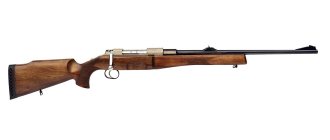German anti-tank rifle
Type Anti-tank rifle, anti-tank rifle
| Mauser Mod. 1918 13.2 mm Tankgewehr | |
| 13.2 mm anti-tank rifle in Army Museum in Paris | |
| Type | Anti-tank rifle, anti-tank rifle |
| Place of origin | German Empire |
| Service history | |
| In service | 1918–1933 |
| Used |
|
| Wars |
|
| Production history | |
| Manufacturer | Mauser |
| Produced | January 1918 |
| No built | 15800 [2] |
| Options | M1918 short Magazine-fed [3] |
| Characteristics | |
| Weight | 15.9 kg (35 lb), 18.5 kg (41 lb) with bipod |
| Length | 169.1 cm (5 ft 7 in) |
| Crew | crew of two |
| Cartridge | 13.2 mm TuF (German: Tank und Flieger) |
| Caliber | 13.2 mm (0.525 in) |
| Action | gate |
| Rate of fire | single shot |
| Effective firing range | 500 m (550 yd) |
| Feeding system | management |
| Attractions | 1000–5000 m (1100–5500 yd) (V notched) |
Mauser 13 mm anti-tank rifle
(German: Tankgewehr M1918, usually abbreviated
T-Gewehr
[4] [5]) is the world's first anti-tank rifle [6]—the first rifle designed for the sole purpose of destroying armored targets—and the only anti-tank rifle adopted during First World War. Approximately 15,800 examples were produced. [2]
History[edit]
During the First World War, the emergence of static trench warfare led to an increase in the use of armor plate for personal protection, and the development and use of armor-piercing ammunition to counter this. Both Britain and Germany used high-powered rifles such as the "elephant guns" from their African colonies for this purpose. Armored fighting vehicles (tanks) were first used by the British at the Battle of Flers-Courcelette in September 1916, and then by the French. By June 1917, the German Army encountered the Mark IV tank and found that the standard 7.92 mm armor-piercing bullet was no longer effective. This prompted the Germans to develop a large-caliber, rapid-fire rifle as an anti-tank weapon. This gun was inspired by weapons used to hunt African big game, such as the Elephant gun. [7] Mauser responded 13 —
mm
T-gewehr rifle
and began mass production in Oberndorfen-Neckar in May 1918. The first of them were released onto the assembly line to specially raised anti-tank detachments.
Anti-tank rifle Mauser Tankgewehr M1918
The Mauser Tankgewehr M1918 is the first ever anti-tank rifle, developed in Germany in 1918.
It is not surprising that the first anti-tank rifle was created in Germany, because it was this country that was the first to face tanks in battle.
History of creation and production
In November 1917, the Mauser received the task of designing an anti-tank rifle, and already on January 21, 1918, the first sample of the new weapon was presented to the command of the Kaiser's army.
Having successfully passed military tests, this anti-tank rifle was adopted by the Reichswehr under the designation Mauser Tankgewehr M1918 , which became better known as Mauser T-gewehr (it was also known as the 13 mm Tank Abwehr Gewehr M1918 or Elefant-Büchse - elephant gun).
The Mauser T-gewehr anti-tank rifle was developed to use a special 13 mm T-Patrone cartridge created by the German company Polte .
Of the planned 30,000 units before the end of the war, German industry managed to produce 15,800 guns, of which 4,632 anti-tank guns were in front-line units in September 1918. Initially, new weapons were issued at the rate of 1 piece per battalion, and from August of the same year, with an increase in their total number, each infantry company was supposed to receive one gun.
German anti-tank crew in position
At the end of 1918, Mauser made an attempt to improve its PTR by mounting a single-row magazine with five rounds under the fore-end and equipping the butt with a spring shock absorber, but this gun remained only in a prototype version.
During the Second World War, the Mauser Tankgewehr was briefly reborn. When the German army invaded the Soviet Union, the Red Army demanded a large number of anti-tank rifles. In July 1941, it was decided to launch production of the German Mauser anti-tank rifle of the 1918 model, recalibrated for the Soviet 12.7 mm cartridge. The Soviet copy of the anti-tank rifle had a muzzle brake and a powerful shock absorber on the butt. The rear sight had graduations with divisions of 200, 400 and 600 m. The production of anti-tank rifles was launched at the Moscow Higher Technical School. Bauman , where several hundred copies were made. These anti-tank rifles were used in the defense of Moscow. Soon, Soviet industry mastered the production of 14.5-mm PTRD and PTRS anti-tank rifles, after which further production of a copy of the Mauser anti-tank rifle was discontinued.
Design and principle of operation
The Mauser T-Gewehr PTR was an enlarged single-shot Mauser 98 rifle with manual reloading, adapted to use a powerful cartridge. The barrel is locked using a rotary sliding bolt. In addition to two lugs in the front part of the bolt, there are two more protrusions in its rear part (the rifle had a cylindrical bolt with four lugs instead of the usual three lugs for Mauser rifles - the bolt had to be strengthened, taking into account the increased pressure of the powder gases of the more powerful ammunition).
The gun has a wooden stock with a pistol grip, in the front of which there is a removable bipod from the MG-08/15 machine gun. The open, adjustable sight is designed for shooting at ranges from 100 to 500 meters.
The armor penetration of PTRs was quite sufficient for that time: at a distance of 100 m - 20 mm; at 300 m - 15 mm, which made this weapon a formidable opponent for all types of tanks, especially since, in combination with a relatively low weight (17.7 kg with bipod), it allowed mobility in battle, the possibility of camouflage and the ability to constantly be in combat infantry formations, thereby providing its support with powerful close-combat anti-tank weapons. The shooting was carried out with a cartridge with an armor-piercing bullet capable of penetrating armor, hitting the crew of a tank or armored car with fragments of bullets and armor.
British soldiers with captured Mauser T-gewehr
Along with numerous advantages, the Mauser T-Gewehr had a number of major disadvantages, which included: bulkiness, which led to insufficient maneuverability of the gun, low rate of fire and strong recoil. The recoil was so sharp and strong that the shooter was often injured when fired, even despite the overcoat placed under the butt. The shooters, if possible, changed places after 3-4 shots. Another unpleasant feature of the rifle was the short life of the barrel - high pressures had a strong effect on the barrel of the weapon, accelerating its wear.
Video
Shooting from a Mauser T-gewehr, handling weapons, etc.:
Mauser T-gewehr
| TACTICAL AND TECHNICAL CHARACTERISTICS OF ANTI-TANK RIFLE MAUSER TANKGEWEHR M1918 | |
| Manufacturer: | Mauser Werke AG |
| Cartridge: | 13.25x92mm SR |
| Caliber: | 13.2 mm |
| Weight without cartridges: | 16.6 kg |
| Weight with cartridges: | 18.5 kg |
| Length: | 1691 mm |
| Barrel length: | 960 mm |
| Number of rifling in the barrel: | 4 right-hand |
| Trigger mechanism (trigger): | Impact type |
| Operating principle: | Sliding butterfly valve |
| Fuse: | Flag fuse |
| Aim: | Front sight and sector sight |
| Effective range: | 200 m |
| Sighting range: | 500 m |
| Initial bullet speed: | 786 m/s |
| Armor penetration at a meeting angle of 90°: | at 300 m - 15 mm, at 100 m - 20 mm |
| Type of ammunition: | Single shot |
| Number of cartridges: | 1 |
| Years of production: | 1918–1919 |
Operation[edit]
The rifle was a single-shot bolt-action rifle of a modified Mauser action, with cartridges loaded into the chamber by hand. The weapon had a pistol grip and bipod, but did not have recoil mitigation features such as a soft stock or muzzle brake. This could cause problems for the shooter when firing again. The sighting sights were composed of a front blade and a rear tangent, finished in 100 meter increments from 100 to 500 meters. The rifle was operated by a two-man crew: a gunner and an ammunition bearer, who were both trained to fire the weapon. Due to the enormous blunt force of the recoil, it was designed to be fired in a static position, prone or from a trench.
1st anti-tank rifle Mauser T-Gewehr M1918
In the previous article about anti-tank rifles, one could get acquainted with the anti-tank gun, made in England and bearing the name of the gun’s project manager. We are talking about the Boys anti-tank rifle. But this is far from the first PTR, and especially those models that are pioneers of their own arouse particular enthusiasm. In this article, I propose that you get acquainted with such a weapon, especially since this standard showed all the positive and negative properties of such a weapon as an anti-tank rifle and had a significant impact on the future development of this type of firearm. We are, in fact, talking about the first anti-tank rifle, which was produced in Germany back in 1918, and specifically about the Mauser T-Gewehr M1918. There is nothing unusual in the fact that the first anti-tank rifle was created in Germany, because it was in this country that the first had to get acquainted with tanks in battle. Naturally, the tanks of the First World War had properties that were far from the highest, especially by modern standards, and many models from that time can now cause a grin. Still, it was a rather harsh weapon, both then and now, and it would be completely inappropriate to smile when meeting them. In view of the fact that tanks were becoming increasingly widespread, there was an urgent need to create a means of combating them that would be common in production and maintenance, effective and at the same time cheap. Multi-caliber machine guns were ideally suited for these purposes, but their weight did not allow the machine gun crew to quickly change the position of the machine gun crew on the battlefield, so a more maneuverable means of combating armored vehicles was required, and the Mauser T-Gewehr M1918 anti-tank rifle became such a weapon.
Unfortunately, nothing is clear about exactly whose idea it was to make the first anti-tank gun, because in November 1917 the Mauser arms company received a specific task to adapt the Mauser 98 for the more powerful 13x92 cartridge, and already on January 21 of the next year the gun was presented to the military as a completely ready-made standard. The gun retains the general features of the Mauser 98, but it’s still not worth calling the models similar. The presented standard differed in quite a few ways from its own progenitor. Naturally, at first it was the dimensions and weight of the gun, and not only them. The base of the gun included a longitudinally sliding bolt that locked the barrel bore when turning, but unlike the Mauser 98 bolt, the bolt of the Mauser T-Gewehr M1918 anti-tank rifle had 4 stops, onto which the barrel bore was closed. Two of them were placed in the front part of the shutter, and two more in the rear. The gun did not have a magazine, in other words, in fact, it was single-shot. New ammunition was supplied through a window for ejecting spent cartridges. Despite the apparent simplicity of this simple manipulation of the gun, the practical rate of fire was only 6 rounds per minute. The anti-tank rifle did not have any devices that would dampen recoil when firing; there was not even a butt plate on the butt. Interestingly, the weapon had a separate pistol grip for comfortable holding. In addition, an anti-tank rifle
The Mauser T-Gewehr M1918 also had a bipod, which was attached to the front of the forearm. The sighting devices of the gun consist of a rear sight and a front sight and are designed for firing from 100 to 500 meters. In general, the PTR had quite a few differences from its progenitor, although taking into account the general simplicity of the bolt-action gun, one cannot say that the gun was fundamentally different from its smaller-caliber prototype.
The weight of the gun was 17.7 kilograms, while the length of the anti-tank rifle was 1680 mm. PTR barrel length is 984 mm. In general, it turned out to be a rather severe fool in terms of size and weight, although what is 17 kilograms when you want to live, especially since the crew of the anti-tank rifle included 2 people, so this weapon moved quite quickly across the battlefield.
The gun itself without a cartridge is just iron, the combat properties of which are zero, and the ammunition of the Mauser T-Gewehr M1918 anti-tank rifle was fascinating at that time. The development of this cartridge was entrusted not to Mauser, but to Polte, and the company completely coped with this task. True, the cartridge was developed not for the Mauser T-Gewehr M1918 anti-tank rifle, but for the MG 18 multi-caliber machine gun. Although they usually say that the cartridge was developed taking into account use in both a machine gun and an anti-tank rifle, I find it hard to believe that the Germans made a bet immediately into two types of weapons, one of which has not yet proven itself. Therefore, I think it is more logical that the cartridge was developed specifically for a machine gun, and in the PTR it was already used as ammunition suitable for the gun. The metric designation of this ammunition is 13x92, but the more well-known name is T-Patron. The ammunition consisted of a bullet with an armor-piercing core, packed in a lead jacket and a bimetallic shell, a brass sleeve with a groove and a protruding rim with a central firing capsule, and a charge of nitrocellulose gunpowder weighing 13 grams. The cartridge bullet weighed 62.5 grams.
A notable feature of this ammunition was that it was designed for a machine gun, and was most widely used in anti-tank rifles. The number of machine guns was limited to only fifty units, but the Germans managed to rivet an unlimited number of anti-tank rifles, specifically 15,800 guns, and this was only until the end of 1918, in other words, in less than a year. In general, there is nothing unusual here, because the Mauser T-Gewehr M1918 anti-tank rifle, compared to the MG 18 machine gun, is, one might even say, a primitive and very affordable weapon.
Obviously, like any other weapon, the main question when considering the Mauser T-Gewehr M1918 anti-tank rifle is its effectiveness, in other words, how well this weapon handled its tasks. The armor-piercing ability of this PTR was more than satisfactory at that time. So, at a distance of 100 meters, the anti-tank rifle successfully pierced a sheet of armor 26 mm wide. When the distance to the target increased to 200 meters, the thickness of the penetrated armor was reduced to 23.5 mm. At a distance of 400 meters, the gun penetrated armor 21.5 mm wide, and at five hundred meters - 18 mm. It would seem that the characteristics are more than excellent, but they are all designed for the fact that the bullet hits at an angle of 90 degrees with respect to the armor plate being penetrated, so not everything is as excellent as it might seem at first glance. In general, this was more than enough for the tanks of the First World War, so there were no special complaints about the weapon here.
But a significant disadvantage was that the weapon was new in its own way, and the shooters often did not understand much about how to use it well. The fact is that an anti-tank rifle bullet remains an ordinary bullet with the highest penetration. Thus, in addition to the fact that it was necessary to get into the tank, which is not so difficult, it was necessary to get into certain places, which was already significantly more difficult. The crews of the Mauser T-Gewehr M1918 anti-tank rifles had to specifically know the design of their own targets, and besides, be able to shoot from anti-tank rifles with not the highest accuracy so as to hit the main components, places where the crew is located, etc.. In fact, this is was the main problem with the PTR. A striking example is those situations when tanks were a sieve, but their crew was alive, and the equipment itself was still working. Naturally, great importance was also played by the fact that the anti-tank
the crew was simply lost in a situation where more than 10 shots were fired at the tank, and it still continued to move and fought. Thus, it was necessary to completely reconsider the approach to training crews of anti-tank rifles, spending many hours on training, most of which were devoted to the design of tanks, their weak points, and the location of the crew in the vehicle. As a result, it was possible to repeatedly increase the effectiveness of the weapon, which once again proves that even the most perfect standard is useless in untrained hands.
If we touch on the issue of negative properties specifically of the Mauser
T-Gewehr M1918, then there is a solid list here too.
The main bad thing was that the gun had very strong recoil. Naturally, they tried to fight this, but at the level of anti-tank rifle crews, and not by gunsmith designers. Any means at hand were used to partially compensate for recoil when firing. In most cases, the butt of the gun was wrapped in rags, which created a shock-absorbing layer between the butt and the shooter's shoulder, although this was of little use. A more interesting option was to screw a metal plate curved to the shape of a shoulder onto the back of the butt. This plate increased the area of contact between the butt and the shooter’s shoulder; in addition, the plate itself was wrapped back with a thick layer of rags. All these measures partially compensated for the recoil when firing, but even despite this and the solid weight of the gun, the recoil still remained on the verge of being bearable by a person. In general, the blue shoulder was an obvious sign that the person was firing a Mauser T-Gewehr M1918 .
Also quite common was the change of shooters within the crew, so after firing 3-5 shots, people changed each other, which had a positive effect on the effectiveness of the weapon’s deployment. True, it is necessary to note here that a change of shooter was not always possible and quite a lot of people died at the exact moment when one shooter replaced another, so an exchange could not always be without risk. The second serious drawback of the gun was that the enormous pressure in the bore of the anti-tank rifle led to very rapid wear of the barrel. This was especially noticeable during the first uses of anti-tank guns, when people, not knowing where to shoot, fired a lot of ineffective shots and very quickly the resource of the barrels was exhausted. Well, since the barrel in the weapon was actually one of the most labor-intensive parts to manufacture, we can say that it was necessary to make half of the anti-tank rifle anew in order to revive the weapon. Numbers speak best about this dilemma. A total of 30,000 Mauser T-Gewehr
M1918, but they managed to make only 15,800, while by the end of 1918, less than a third, namely 4,632 guns, were in working order.
Well, the third drawback of the gun was that the accuracy of the Mauser T-Gewehr M1918 anti-tank rifle left much to be desired; one can naturally talk about a confident hit on a tank at a distance of 500 meters, but it’s better to remain silent about an effective hit at this distance . Naturally, when a shooter knows that his gun can fire at a tank at a distance of half a kilometer, he tries to maintain this distance so as not to get close to the enemy’s harsh armored vehicles. Well, because not many people are familiar with such a word as “courage,” most of the crews of anti-tank rifles tried to stay at a very close distance, which, naturally, also affected the effectiveness of the introduction of such a weapon as the Mauser T-Gewehr M1918 anti-tank rifle.
In general, despite all the shortcomings listed above, the Mauser T-Gewehr M1918 anti-tank rifle has established itself as a weapon
quite effective in the fight against armored vehicles.
Even taking into account the fact that its effectiveness in almost everything depended on the skills and knowledge of the crew of the anti-tank gun, almost always on the battlefield this weapon was fully capable of its tasks, relatively quickly disabling armored vehicles and hitting the crew of the vehicle. In fact, this is precisely why the idea of introducing anti-tank rifles in the fight against armored vehicles has received further development. And although most of the following models of anti-tank guns were slightly different in their design and had all the same shortcomings as this first German anti-tank gun, a certain development can be observed not only in the ammunition, but also in the weapon itself. Mauser T-Gewehr
anti-tank rifle directly , they tried to develop it into a more successful standard. Namely, at the end of 1918, the Mauser company introduced a new version of the gun, which was equipped with a detachable magazine with a capacity of 5 rounds, as well as an improved stock with a spring shock absorber. But this version of the PTR did not go into production, and remained an experimental prototype.
The fact that the Mauser T-Gewehr M1918 anti-tank rifle was a very good weapon for its time is also evidenced by the fact that during the period between the two global wars this weapon was intensively used by other countries. The distribution of this gun in Germany was also quite wide during the war. At first it was planned to issue one anti-tank rifle per battalion, but by August 1918 the plans were revised and each infantry company began to be equipped with one anti-tank rifle. After the end of the war, Germany was shackled by the Treaty of Versailles, according to which it was forbidden to develop and create weapons of new systems, which included anti-tank rifles. In general, here we can argue how the system of this anti-tank rifle can be called the newest. In general, despite the contract, in 1932 Germany had 1074 Mauser T-Gewehr M1918 anti-tank rifles in service. In fact, this was the end of the gun in Germany, because after 1932 the Mauser T-Gewehr M1918 was replaced by more advanced models of anti-tank guns, although before the 2nd World War and at its initial stage, these guns were still used, albeit for training firing at armored vehicles. This was the end of the gun's life in Germany.
Despite the fact that in Germany the Mauser T-Gewehr M1918 anti-tank rifle was considered obsolete and was not used in combat, this does not mean that the anti-tank rifle was forgotten. In July 1941, this standard was born again, now on the territory of the Russian Union. As is clear, by the time of the German attack we did not have at our disposal designs of anti-tank rifles, the overall creation of which could be launched quickly and at minimal cost. Everything that was proposed by designers since 1936 either sought improvement, or was very difficult to produce, in addition, we should not forget that the new standards were still untested in battle. The Mauser T-Gewehr M1918 anti-tank rifle went through the war, proved itself to be excellent, and most importantly, it couldn’t have been easier to manufacture. After weighing all the pros and cons, it was decided to expand the creation of the Mauser T-Gewehr M1918, but under the Russian cartridge and with some changes in the weapon itself. One should not think that Russian designers simply “torn out” a German anti-tank rifle ; a lot of work was done before the gun was released. First, it should be noted that the anti-tank rifle began to use the 12.7x108 cartridge, which means that the PTR barrel was completely different, and the properties of the gun itself changed completely. A muzzle brake-recoil compensator was developed for the gun, a shock-absorbing butt plate appeared on the butt, and sighting devices were also changed. The rear sight was calibrated for firing at 200, 400 and 600 meters. The creation of an anti-tank rifle was launched on the basis of the Capital Higher Technical School named after. Bauman, where several hundred of these anti-tank rifles were created. Despite the fact that the times were turbulent, the Russian versions of the Mauser T-Gewehr M1918 were significantly more accurate and more comfortable to use compared to the German ones. In general, we should not forget about the time gap of more than 20 years. With the advent of more advanced and effective PTRD and PTRS, the creation of this anti-tank gun was curtailed and with this the Mauser T-Gewehr M1918 anti-tank gun was already retired completely.
The Mauser T-Gewehr M1918 anti-tank rifle can safely be called a pioneer among anti-tank rifles. This particular weapon showed that in experienced hands, even a relatively small rifle can cope with a tank. Despite the absurdity of the idea itself, the anti-tank rifle more than once prevailed over armored vehicles. Naturally, this weapon also has its drawbacks, and in terms of efficiency it cannot even be compared with a multi-caliber machine gun, but such advantages of the weapon as mobility, simplicity and low cost of production make it an ideal option when you need to defend yourself, but have no money and time for more complex and effective ones. no standards. Despite the fact that many note such a weapon as completely ineffective, in my opinion, for its time, the PTR was a good means of fighting armored vehicles, because the armored vehicles of the beginning of the war and its end were very different. If we take the negative properties of the gun, then it seems to me that the main ones were not high recoil, not ammunition, not weight and not dimensions. The main drawback of this weapon was that the anti-tank crew needed to know the design of the enemy tank, almost better than the crew of this tank, and yet the models of tanks, even at the initial stage of the war, were different, so training the crew of an anti-tank gun took a lot of time, and time, as usual, there was none. As a result of little knowledge about the design of the enemy tank, the crew could not use their gun with the greatest efficiency, in general, the missing knowledge was very quickly gained by the experimental method, and if one hundred percent of the entire experience of the soldiers was systematized and promptly transferred to the replacement, then the effectiveness of the introduction of anti-tank guns would be in my opinion, it would have increased a couple of times.
Cartridge[edit]
Comparison of the standard .303 British rifle cartridge and the 13.2mm T-Gewehr cartridge.
Armor-piercing-hardened steel Powder-coated 13.2 x 92mm (0.525 in) half-cartridge rim, often called simply "13mm", originally planned for the new, heavy Maxim MG.18 water-cooled machine gun, the und Flicher tank
(
TuF
) meaning for use against "tanks and aircraft", which was under development and would enter service in 1919 rounds weighed 51.5 g (795 dp) with a muzzle velocity of 785 m/s (2,580 ft/s) . [8]
| Classify | Penetration at 90° |
| 100 m (110 yards) | 26 mm (1 inch) |
| 200 m (220 yd) | 23.5 mm (0.93 in) |
| 400 m (440 yd) | 21.5 mm (0.85 in) |
| 500 m (550 yd) | 18 mm (0.71 in) [9] |
Surviving examples[edit]
| In this section do not cite any sources . |
Examples of the Mauser 1918 anti-tank rifle can be found in several museums:
- Argentina Museo de Armas, Circulo Militar, Buenos Aires
- Museo de Armas, Colegio Militar de la Nación, El Palomar
- Museo de la Ciudad, San Carlos de Bariloche
- Bandiana Army Museum in Wodonga
- Museum of Military History, Vienna
- At the Flanders Fields Museum, Ypres
- On display in the lobby of the McGill Club in Montreal is a gift given in 1919 by a Canadian general.
- At the Huaihai Campaign Memorial Hall, Xuzhou City, Jiangsu Province
- Army Museum in Invalides, Paris
- Herzog Anton Ulrich Museum in Braunschweig
- National Artillery Museum in Turin
- National Military History Museum in Diekirch
- Lancashire Infantry Museum, Preston
- US Army Armor and Cavalry Collection, Fort Benning
- Latvian War Museum
Surviving examples
| This section do not quote any sources . |
Examples of the Mauser 1918 anti-tank rifle can be found in several museums:
- Argentina Museo de Armas, Circulo Militar, Buenos Aires
- Museo de Armas, Colegio Militar de la Nación, El Palomar
- Museo de la Ciudad, San Carlos de Bariloche
- Bandian Army Museum in Wodonga
- At the Flanders Fields Museum, Ypres
- On display in the lobby of the McGill Club, Montreal, is a gift given in 1919 by a Canadian general
- In the Huaihai Campaign Memorial Hall, Xuzhou City, Jiangsu Province
- At the Musée de l'Armée on Les Invalides, Paris
- Herzog Anton Ulrich Museum in Braunschweig
- At the National Artillery Museum in Turin
- National Military History Museum in Diekirch
- Lancashire Infantry Museum, Preston
- US Army Armor and Cavalry Collection, Fort Benning
- Latvian War Museum
Links[edit]
- https://www.gotavapen.se/gota/artiklar/rifles_se/pvg/at_rifles_se.htm
- ^ a b K. J. Sweeting (2004). Blood and Iron: The German Conquest of Sevastopol. Brassey. p. 108. ISBN 978-1-57488-796-9.
- Robert Ball (2011). Mauser Military Rifles of the World, 5th Edition
. Gun Digest Books. item 193. ISBN. 978-1-4402-1544-5. - Ball, Robert M. (2006). Mauser Military Rifles of the World. Gun Digest Books. item 183. ISBN. 978-0-89689-296-5.
- Stephen Bull (2004). Encyclopedia of Military Equipment and Innovation. Greenwood Publishing Group. paragraph 15. ISBN 978-1-57356-557-8.
- "Anti-tank rifles of the First World War" (Microsoft FrontPage 6.0). Retrieved October 10, 2014.
- Larson 2022.
- Johnson, Melvin M., Jr. (1944). Rifles and machine guns
. New York: William Morrow and Company. item 384. - Natzvaladze, Yuri (1996). Trophies of the Red Army during the Great Patriotic War of 1941–1945. Volume 1
. Scottsdale, AZ: Land O'Sun Printers. clause 9. ASIN B001J7LCD2. - "Mauser T-Gewehr anti-tank rifle". www.awm.gov.au.
_ Australian War Memorial. - "Rocky Hill War Items 'Nationally Significant'". Goulburn Post. December 2015
- Larson, Caleb (August 12, 2022). "The first German anti-tank rifle had African roots". National interest. Retrieved August 20, 2022.CS1 maint: ref=harv (link)
Recommendations
- https://www.gotavapen.se/gota/artiklar/rifles_se/pvg/at_rifles_se.htm
- ^ a b
K. J. Sweeting (2004).
Blood and Iron: The Conquest of Sevastopol by the Germans
. Brassey. paragraph 108. ISBN 978-1-57488-796-9. - Robert Ball (2011). Military Mauser Rifles of the World, 5th Edition
. Gun Digest Books. p. 193. ISBN 978-1-4402-1544-5. - Ball, Robert M. (2006). Mauser Military Rifles of the World
. Gun Digest Books. p. 183. ISBN 978-0-89689-296-5. - Stephen Bull (2004). Encyclopedia of Military Equipment and Innovation
. Greenwood Publishing Group. paragraph 15. ISBN 978-1-57356-557-8. - "Anti-tank rifles of the First World War" (Microsoft FrontPage 6.0). Retrieved October 10, 2014.
- Larson 2022.
- Johnson, Melvin M., Jr. (1944). Rifles and machine guns
. New York: William Morrow and Company. item 384. - Natsuladze, Yuri (1996). Trophies of the Red Army during the Great Patriotic War of 1941–1945.
Volume 1 . Scottsdale, AZ: Land O'Sun Printers. item 9. AS IN B001J7LCD2. - "Mauser T-Gewehr anti-tank rifle." www.awm.gov.au.
_ Australian War Memorial. - "Rocky Hill Military Items 'Nationally Significant'." Goulburn Post. December 2015
- Larson, Caleb (August 12, 2022). "The first German anti-tank rifle had African roots." National interest. Retrieved August 20, 2022.CS1 maint: ref=harv (communication)


